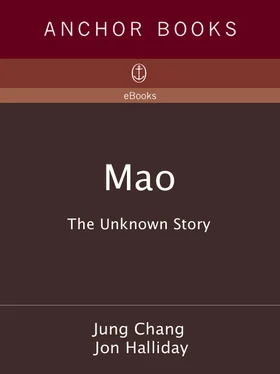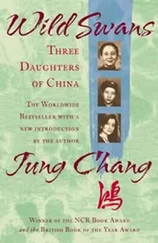AS VIOLENCE ACCELERATED under Mao’s tutelage, the Nationalist army turned against the Soviet model their party was following. A large part of the army was from Hunan, and the officers, who came from relatively prosperous families, found that their parents and relatives were being arrested and abused. But it was not just the better-off who suffered; the rank-and-file were also being hit. Professor Chen reported to the Comintern in June: “even the little money sent home by ordinary soldiers was confiscated,” and the troops were “repelled by the excesses,” seeing that the outcome of their fighting was to bring disaster to their own families.
Many in the Nationalist Party had been unhappy about their leaders adopting Moscow’s line right from the start, when Sun Yat-sen embraced the Russians in the early 1920s. Their anger had reached the boiling point after the Nationalists’ second congress in January 1926, when the much smaller CCP (with far fewer than 10,000 members) seemed to have hijacked the Nationalists, who had several hundred thousand members. Under Wang Ching-wei, one-third of the 256 delegates were Communists. Another third were “on the left,” among whom was a large contingent of secret Communists. Not only had Moscow planted its Trojan horse, the CCP itself, inside the Nationalists, it had also infiltrated a large number of moles. Now, over a year later, the mob violence condoned by their party led many prominent Nationalists to call for a break with Moscow’s control, and with the Chinese Communists.
The crisis quickly came to a head. One thousand kilometers to the north, on 6 April 1927 the Peking authorities raided Russian premises and seized a large cache of documents which revealed that Moscow was engaged in extensive subversion aimed at overthrowing the Peking government and replacing it with a client. The documents also showed secret Soviet links with the Chinese Communists. In fact, one important CCP leader, Li Ta-chao, and some sixty other Chinese Communists were arrested in the Russian compound, where they had been living. Li was soon executed by strangulation.
The raids received wide publicity, as did the documents. The proof of Soviet subversion on a massive scale outraged Chinese public opinion and alarmed Western powers. Unless the Nationalists took decisive action to dissociate themselves from the Russians and the CCP, they risked being seen as part of the conspiracy to turn China into a Soviet satellite. Many Nationalists might leave the party, the general public would be repelled, and the Western powers stiffened in their resolve to give full backing to the Peking regime. It was at this point that the commander-in-chief of the Nationalist army, Chiang Kai-shek, took action. On 12 April he gave orders to “cleanse” the Nationalist Party of Communist influence. He issued a wanted list of 197 Communists, headed by Borodin and including Mao Tse-tung.
CHIANG KAI-SHEK HAD been born into a salt merchant family in the east coast province of Zhejiang in 1887, six years before Mao. Later familiar abroad as “the Generalissimo,” he was a professional military man, and in public presented a stolid, rather remote and humorless appearance. He had trained in Japan, and in 1923, as Nationalist chief of staff, had headed a mission to Soviet Russia. At the time he was regarded by the Russians as on the “left wing of the Nationalists” and “very close to us,” but his three-month visit turned him profoundly anti-Soviet, particularly on the issue of class struggle: he was deeply averse to Moscow’s insistence on dividing Chinese society into classes and making them fight each other.
But Chiang did not breathe a word in public about his real views when he returned to China. On the contrary, he gave Borodin the impression that he was “extremely friendly to us, and full of enthusiasm.” He concealed his true colors for one simple reason — the Nationalists were dependent on Soviet military assistance for their goal of conquering China. Chiang, who meanwhile had risen to No. 2 in the Nationalist Party, had, however, been quietly preparing the ground for a split, and had already removed some Communists from key positions in March 1926. This caused the Russians to start plotting ways to get rid of him. According to one of their agents in Canton, their idea was “to play for time and prepare the liquidation of this general [Chiang].” A year later, in early 1927, Borodin had issued a secret order to have Chiang arrested, though the plan did not materialize.
The moment the Peking government published documents about Russian subversion, Chiang acted. On 12 April, he issued a notice which said, in essence: arrest Communists. He moved first in Shanghai, which had been the HQ of the CCP, and where he himself was. The Communists had armed pickets there. Chiang took steps to disarm them. Towards this end he enlisted gangsters to pick a fight with the pickets, to create an excuse for his army to descend and confiscate the arms. Communist strongholds were assaulted, many trade union leaders arrested, and some shot. Chiang’s troops opened fire with machine-guns on a subsequent protest march. In the space of a few days, there were probably more than 300 deaths on the Communist side. Chiang had broken the Communists as an organized force able to operate in public in Shanghai, though the CCP leadership remained largely intact — and, amazingly, Shanghai continued to be where the Party Center resided and operated, clandestinely, even in the middle of the purge. For the following five or six years, “Shanghai” was synonymous with the CCP leadership (and we use it in this sense).
After Chiang Kai-shek started killing Communists in Shanghai, Nationalist chief Wang Ching-wei, who was in Wuhan, some 600 km inland, broke with the CCP and submitted to Chiang. From now on, Chiang Kai-shek became the head of the Nationalist Party. He went on to build a regime that lasted twenty-two years on the mainland, until he was driven to Taiwan by Mao in 1949.
IN THE LEAD-UP TO Wang’s split, Mao faced a choice. He had been much more appreciated by Wang than by his fellow Communists and most Russians, and he had risen much higher among the Nationalists than in the CCP. Should he now go with Wang? He was later to say of this time: “I felt desolate, and for a while, didn’t know what to do.” It was in this rather torn state of mind that one day he ascended a beautiful pavilion on the bank of the Yangtze in Wuhan. Originally built in AD 223 the Yellow Crane Pavilion was a landmark. Legend had it that here a man had once beckoned to a yellow crane flying along the Yangtze, rode on its back to the Celestial Palace — and never returned. The Yellow Crane thus came to mean something gone forever. Now it seemed an apt metaphor for everything Mao had built up for himself in the Nationalist Party. It was a day darkened with heavy rain. As he stood by the carved balustrade of the pavilion, looking across the vastness of the Yangtze, “locked in,” as he wrote in a poem, between Mount Snake and Mount Tortoise on either side, but extended to the infinite by the deluge from the sky, Mao pondered his alternatives. In a traditional libation, he poured his drink into the torrent below, and finished his poem with the line: “The tide of my heart soars with the mighty waves!”
Mao made a bid to keep Wang on the Communists’ side by disowning the peasant association thugs whom he had previously hailed as wonderful, and casting them as scapegoats. On 13 June, Wang Ching-wei told other Wuhan leaders: “Only after Comrade Mao Tse-tung’s report did we realise that peasant associations are controlled by gangsters. They don’t know anything about the Nationalists or the Communists, they only know the business of killing and arson.” Mao’s attempt to pass the buck was futile. His Nationalist mentor was already planning to break with the Communists, and blame them for all the rural atrocities. As the most vocal promoter of this violence, Mao had to say goodbye to Wang and the Nationalists. He was already on the wanted list. But quite apart from this, to stay with Wang would mean having to become a moderate, and respect social order. Mao was not prepared to do this, not after he had discovered his fondness for brutality in rural Hunan. Nearly a decade before, as a 24-year-old, he had expressed his craving for violent and drastic social change: “the country must be … destroyed and then re-formed … People like me long for its destruction …” The Soviet model suited his impulse.
Читать дальше










